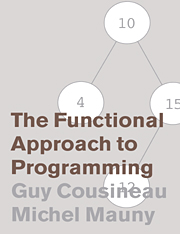II - Applications
Published online by Cambridge University Press: 05 June 2012
Summary
Here we begin the second part of this book; it is dedicated to writing various applications in Caml. Its chapters are largely independent of one another, so you can read them separately, choosing them according to your own interests or according to the needs of a course.
Chapter 5 covers symbolic computations over formal terms. In particular, it defines algorithms for pattern matching and unification used in many applications of symbolic computations, such as automatic proof, logic programming, or type synthesis.
Chapter 6 shows how to use balanced trees to represent large bodies of information. It uses the ideas of binary search trees and AVL trees as introduced in every course about algorithms.
Chapter 7 goes deeply into the methods of exploring graphs. It uses techniques of set representation introduced in Chapter 6 and presents applications from the domain of games such as the red donkey or solitaire.
Chapter 8 takes up the writing of lexical and syntactic analyzers. It uses the idea of a Caml stream.
Chapter 9 shows how to program drawing and designs. It first succinctly describes and then exploits the MLgraph library to draw trees and to tile planes and surfaces.
Chapter 10 deals with exact arithmetic, taking into account integers and rational numbers of arbitrary size. It does not attempt to describe a complete and efficient implementation of a library for large numbers, but rather, it tries to convince you that such a project is feasible.
- Type
- Chapter
- Information
- The Functional Approach to Programming , pp. 133 - 134Publisher: Cambridge University PressPrint publication year: 1998



